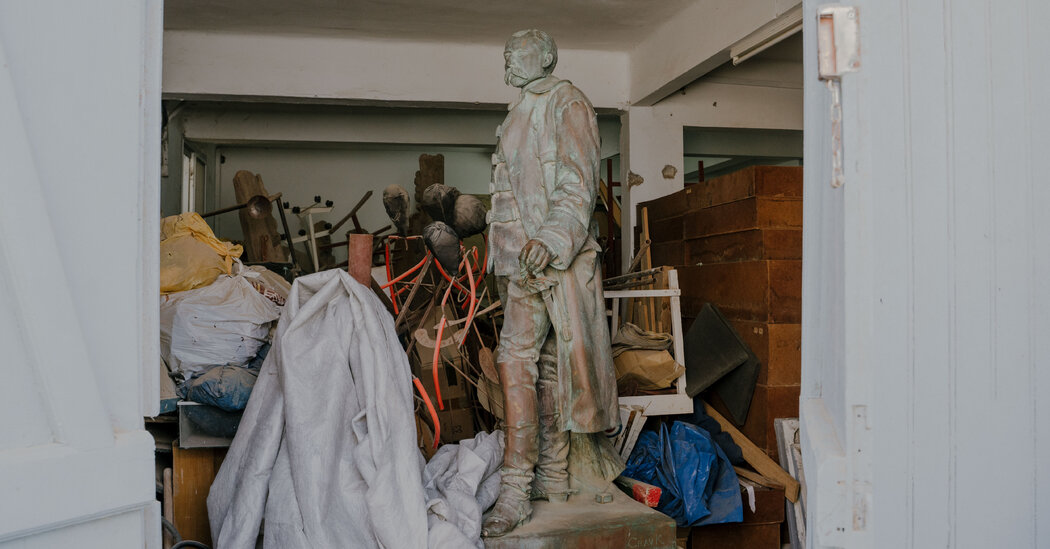
SAINT-LOUIS, Senegal — For more than a century, the French general who shaped Senegal’s former capital was hailed as a hero and a father figure, his bronze statue triumphantly standing on a square that bore his name.
Under his feet, carved into the stone of a massive pedestal, a message read: “To its governor Faidherbe, Senegal is grateful.”
But as more Senegalese become aware of Louis Faidherbe’s ambivalent legacy, many are no longer so grateful. A general and an engineer, he was also a colonizer who in the 19th century led military expeditions that killed tens of thousands of people, burned villages and forced local leaders to surrender.
Faidherbe’s statue was removed from Saint-Louis, a coastal city in Senegal’s north, in 2020 — officially a temporary move — after being toppled and sprayed with paint. While local officials dithered over its fate, its whereabouts remained a mystery, and many want to keep it that way.
The uncertainty around the Faidherbe statue echoes the reckoning that has gripped Senegal, a West African nation of 17 million people that became independent from France in 1960. Many residents of Saint-Louis can no longer bear the sight of a colonizer’s statue, but what to do with the remnants of a troubled colonial past remains contentious.
Across Senegal, streets and squares once dedicated to French figures have been renamed, and a nationwide project aimed at publishing a new general history of the country has mobilized hundreds of researchers.
As anti-French sentiment has emerged here and in others parts of West Africa, the debate around the Faidherbe statue has become heated.
Some want to throw it in the river, as protesters in Bristol, England, did with the statue of a slave trader. Others want it in a museum, or returned to France.
Similar episodes have occurred across Africa for years: In 2015, students at the University of Cape Town succeeded in removing a statue of the British imperialist Cecil Rhodes, while a statue of Queen Victoria was knocked down in Nairobi, Kenya, the same year. In the Democratic Republic of Congo, a statue of Leopold II that was installed in 2005 and taken down a day later because of public outcry now stands in a Kinshasa park with military guards.
In Saint-Louis, the Faidherbe statue is just one element of the general’s legacy. The main city bridge is named after him. So was a prestigious high school, until recently. Residents still refer to the renamed square where the statue once stood as Place Faidherbe.
“So many Faidherbes in Saint-Louis, you’d think he is a god,” said Abdoul Sow, a heritage professor at the city’s Gaston Berger University.
But Thierno Dicko, a local activist who campaigned for the statue’s removal, said the sword and military cap that Faidherbe holds symbolize domination that shouldn’t be displayed.
“How can I tell my son that Senegal is grateful to him after what he did?” Mr. Dicko, 36, asked on a recent evening, his 6-year-old son sitting nearby.
Born in the French city of Lille in 1818, Faidherbe led brutal military expeditions in what is now Senegal, subjugating local people and participating in France’s bloody expansion across West Africa in the mid-19th century.
Faidherbe also gave Saint-Louis its first secular schools for Muslim pupils, a Muslim court, its administrative organization and a vast urbanization plan. It was the capital of French West Africa until 1902, and the colonial quarter on the island in the city’s historic center, known for its pastel-colored houses and colonial architecture, built before Mr. Faidherbe’s governorship, has been a UNESCO World Heritage Site since 2000.
Historians say Faidherbe mixed well with the locals and spoke Wolof, one of Senegal’s national languages. Senegal’s first president, Léopold Cédar Senghor, would later describe him as a friend of Senegal. But that he served French interests and that the schools he built framed colonization in a positive light are widely agreed upon. Even his home city, Lille, is debating the future of a Faidherbe statue in its central square.
Fatima Fall Niang, the director of Saint-Louis’s conservation center, said that she welcomed the new light shed on Senegal’s colonial history, but argued that Saint-Louis wouldn’t be what it is today without Faidherbe.
“If you remove the statue, something is missing,” she said. “It’s about the city’s history.”
Growing up, she and her peers would refer to the general as Maam Faidherbe, Grandpa Faidherbe.
Louis Camara, a 72-year-old writer who lives on the island of Saint-Louis, said that he considered Faidherbe a tutelar figure whose legacy had shaped his childhood — he would play hide-and-seek around the statue — and that he had long played down Faidherbe’s offenses.
“A lot of us have overlooked the dark side of the character,” he said. “But that is also part of history.”
France and Its Colonial Past in Africa
A troubling history. Decades after independence, relations between several African countries and France, a former colonial ruler, remain complex. Here are key things to know:
But the statue that used to tower over residents has disappeared. The official version still goes that it fell in 2017 because of strong winds and heavy rains. It was quickly reinstalled but removed in early 2020, officially to renovate the square.
Across the city, some students said they didn’t even remember that a statue had once stood on the square. Others argued that regardless of its location, they had more balanced views on colonization than their parents.
At the former Faidherbe high school, now named after Omar Foutiyou Tall, an 18th-century Muslim scholar and political leader, Coumba Gueye, a 16-year-old student, said learning about both the crimes and changes that occurred during colonization — or what she called getting “the full picture” — made her feel good. “Ignorance, one way or another, won’t lead us anywhere,” she said.
With or without Faidherbe, the last visible vestiges of the colonial presence are falling into ruin in Saint-Louis. Many families can’t afford to renovate the colonial architecture that the island is known for, and the roof of Mr. Camara’s house collapsed years ago. “I sometimes cry when I walk these streets,” he said.
The rest of Saint-Louis is moving on. Most of its residents live on the city’s eastern bank, with its bustling markets and new neighborhoods. On the western bank, poorer families relying on fishing are directly affected by coastal erosion, their crumbling houses bearing the brunt of climate change as they are relocated to temporary settlements.
On the island, local officials have repeatedly delayed a decision on the statue’s fate.
Abdoulkarim Fa, a curator at the conservation center, said that in a survey he conducted in 2019, a majority of the Saint-Louis population felt frustrated that officials were still giving so much credit to colonial figures. Still, little is changing, he said.
“Senegal is unable to have this difficult conversation,” he said. “In the public psyche, some things must be kept quiet forever.”
The statue’s fate remains unknown to most, but it turns out it hasn’t gone far.
Down the stairs of the conservation center, it rests in a dark basement amid disused furniture and other relics, covered with a dusty blanket. Faidherbe’s trench coat and boots have turned green, and the scratches from its fall years ago remain visible.
A city official from Saint-Louis and a French official, both speaking on the condition of anonymity because of the topic’s sensitivity, said the statue would not be reinstalled on the square.
Ms. Niang, who heads the conservation center but isn’t responsible for the statue, said she hoped local officials would soon take it away. Its presence there, she said, could only cause her trouble.
The pedestal expressing Senegal’s gratefulness to Faidherbe was nowhere to be seen in the basement.




